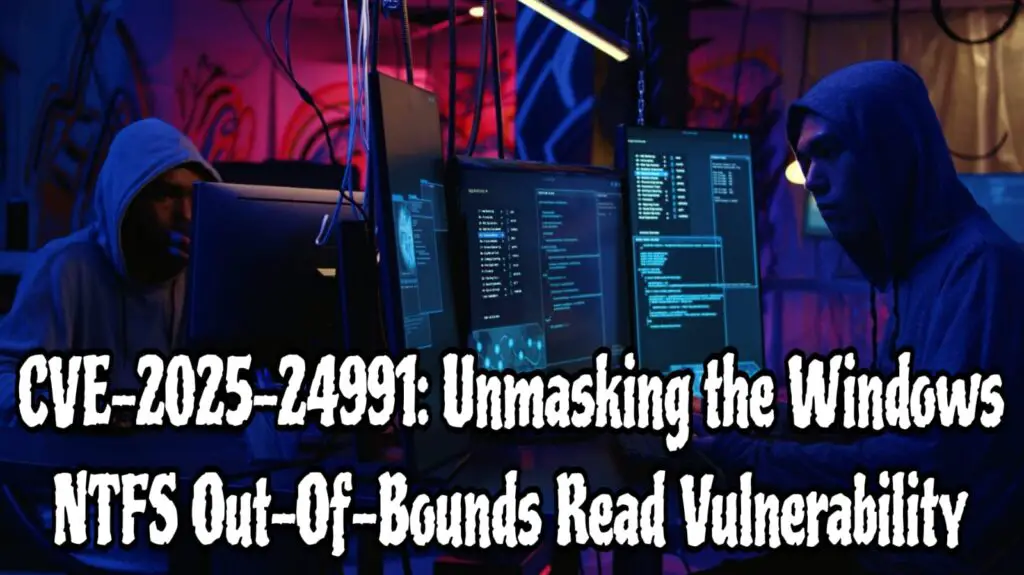CVE-2025-24991: Unmasking the Windows NTFS Out-Of-Bounds Read Vulnerability

Introduction
In the ever-evolving landscape of cybersecurity, vigilance is paramount. One of the latest threats demanding immediate attention is the CVE-2025-24991 vulnerability, a critical flaw within Microsoft’s Windows New Technology File System (NTFS). This vulnerability poses a significant risk to data integrity and system security across various Windows platforms. In this comprehensive analysis, we delve into the intricacies of CVE-2025-24991, identify the affected operating systems, and outline aggressive mitigation strategies, including the essential KB patch numbers.
Understanding CVE-2025-24991
CVE-2025-24991 is classified as an out-of-bounds read vulnerability within Windows NTFS. An out-of-bounds read occurs when a program reads data beyond the boundaries of allocated memory, leading to unintended behavior. In the context of NTFS, this flaw could allow an attacker to exploit the system, potentially leading to information disclosure, privilege escalation, or system crashes.
The Common Weakness Enumeration (CWE) associated with this vulnerability is CWE-125, which pertains to out-of-bounds read issues. These vulnerabilities are critical as they can be leveraged to access sensitive information or destabilize system operations.
Potential Impacts:
- Unauthorized access to sensitive system data.
- System instability, crashes, or blue screen errors.
- Potential foothold for remote code execution (RCE).
Affected Operating Systems
The CVE-2025-24991 vulnerability impacts a broad spectrum of Windows operating systems, including:
- Windows 11
- Windows 10
- Windows Server 2025
- Windows Server 2022
This extensive range of affected systems underscores the urgency for users and administrators to implement corrective measures without delay.
How Attackers Can Exploit This Vulnerability
Attackers can take advantage of CVE-2025-24991 through multiple methods, including:
- Malicious File Execution: Attackers can craft malicious NTFS file structures that trigger out-of-bounds read operations when accessed.
- Local Privilege Escalation: If an attacker gains limited access to a system, they could exploit this flaw to escalate privileges.
- Exploiting Weak System Configurations: Systems that do not enforce strict access controls or have outdated security policies are at higher risk.
Once exploited, attackers could extract sensitive information from memory, crash the system, or even set the stage for deeper exploits such as Remote Code Execution (RCE) or Denial of Service (DoS) attacks.
Mitigation Strategies
Addressing CVE-2025-24991 requires a multifaceted approach to ensure comprehensive protection:
1. Immediate Deployment of Security Patches
Microsoft has released security updates to rectify the CVE-2025-24991 vulnerability. Users and administrators must prioritize the installation of these patches immediately.
The specific Knowledge Base (KB) patch numbers addressing this vulnerability are:
- KB5053598 – Windows 11 v24H2, Windows Server 2025.
- KB5053602 – Windows 11 v23H2, v22H2.
- KB5053606 – Windows 10 v22H2.
These updates are available through Windows Update, Windows Server Update Services (WSUS), and the Microsoft Update Catalog.
2. Enforce Principle of Least Privilege (PoLP)
Restrict user permissions to minimize the risk of privilege escalation attacks. Ensure that:
- Users have only the necessary permissions to perform their tasks.
- System and administrator accounts are secured with strict access controls.
3. Enable Windows Defender Exploit Guard
Use Windows Defender Exploit Guard to detect and prevent exploitation attempts. Ensure:
- Controlled Folder Access is enabled.
- Attack Surface Reduction (ASR) rules are configured to block NTFS exploits.
4. Regular System Backups
Maintaining frequent and encrypted backups ensures that, in the event of an exploit, systems can be restored to a secure state with minimal data loss.
5. Network Security Enhancements
Implement robust network security measures, such as:
- Firewalls and Intrusion Detection Systems (IDS) to detect malicious access attempts.
- Network segmentation to isolate critical assets.
6. User Education and Awareness
Educating users about the importance of applying updates and recognizing potential security threats can significantly reduce the risk of exploitation.
Microsoft’s Response and Patch Effectiveness
Microsoft swiftly addressed CVE-2025-24991 by releasing patches through their Patch Tuesday updates. These patches are engineered to fix the memory read error within NTFS, ensuring that unauthorized access to system memory is prevented.
However, history has shown that some patches can cause system instability, so it is crucial for organizations to test patches in staging environments before full deployment.
Real-World Implications
If left unpatched, CVE-2025-24991 could lead to major security breaches, especially in corporate environments where NTFS is heavily used for file storage and access control. Potential real-world scenarios include:
- Enterprise Network Breaches: Attackers could exploit this vulnerability to gain unauthorized access to sensitive corporate data.
- Government and Healthcare Systems: With NTFS widely used in critical infrastructure, unpatched systems could be targeted for ransomware attacks.
- Financial Institutions: Banks and financial firms relying on Windows servers could be vulnerable to data theft.
The severity of this vulnerability highlights the necessity for proactive security measures and aggressive patch management.
Final Thoughts
The CVE-2025-24991 vulnerability presents a serious threat to the security and stability of Windows systems. Immediate action is non-negotiable. By promptly applying the designated security patches (KB5053598, KB5053602, KB5053606) and adhering to best practices in system maintenance and security, users and organizations can protect their assets against this critical vulnerability.
🔴 DO NOT WAIT! Deploy security patches now and ensure your systems are fortified against CVE-2025-24991 today! 🔴
Related posts:
- How to Download offline setup of Microsoft Store App
- Mitigate WinVerifyTrust Signature Validation Vulnerability CVE-2013-3900
- Zero Trust Security – Fortifying Your Digital Kingdom in the Modern Age
- [Solved] How to solve Windows update error 0x800f0831- CBS E_STORE_CORRUPTION
- [Solved] CVE-2024-35250-Windows Kernel-Mode Driver Elevation of Privilege Vulnerability
- BeyondTrust Privileged Remote Access and Remote Support products Vulnerability (CVE-2024-12356 & CVE-2024-12686
- NIST CSF 2.0 and Penetration Testing: All You Need to Know
- Chained for Attack: OpenVPN Vulnerabilities Leading to RCE and LPE
- March 2025 Patch Tuesday: A Stabilizing Security Landscape
- [Solved] CVE-2025-24983 Microsoft Windows Win32k Use-After-Free Vulnerability

маркетплейс аккаунтов соцсетей маркетплейсов аккаунтов
buy bm facebook https://business-manager-for-sale.org/
business manager for sale https://buy-business-manager-verified.org
buy facebook bm buy-bm.org
tiktok ads account for sale https://buy-tiktok-ads-accounts.org